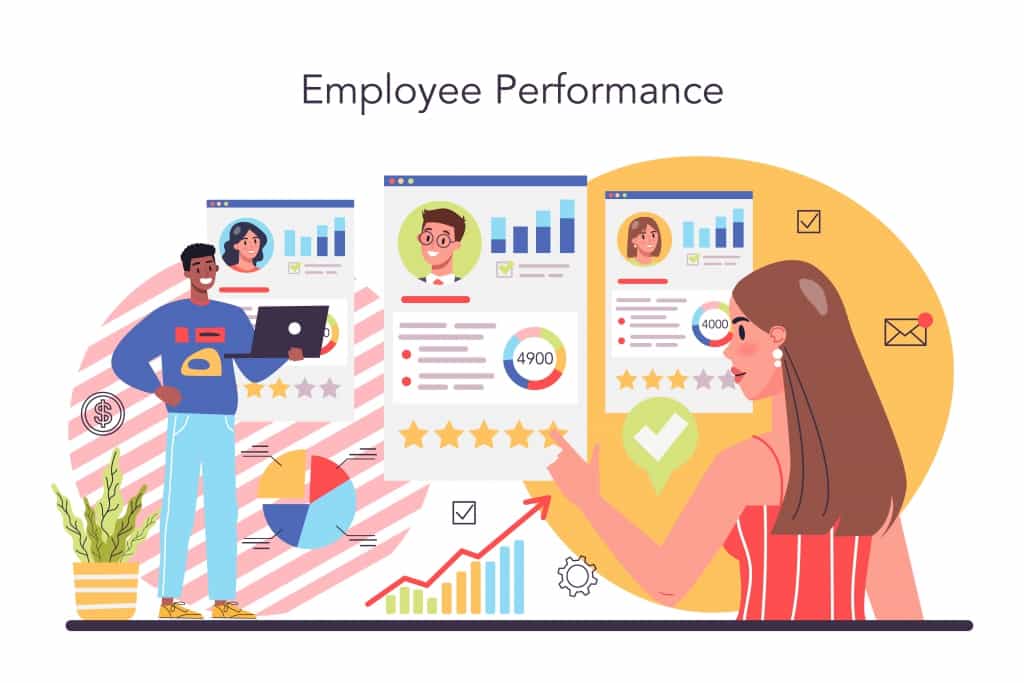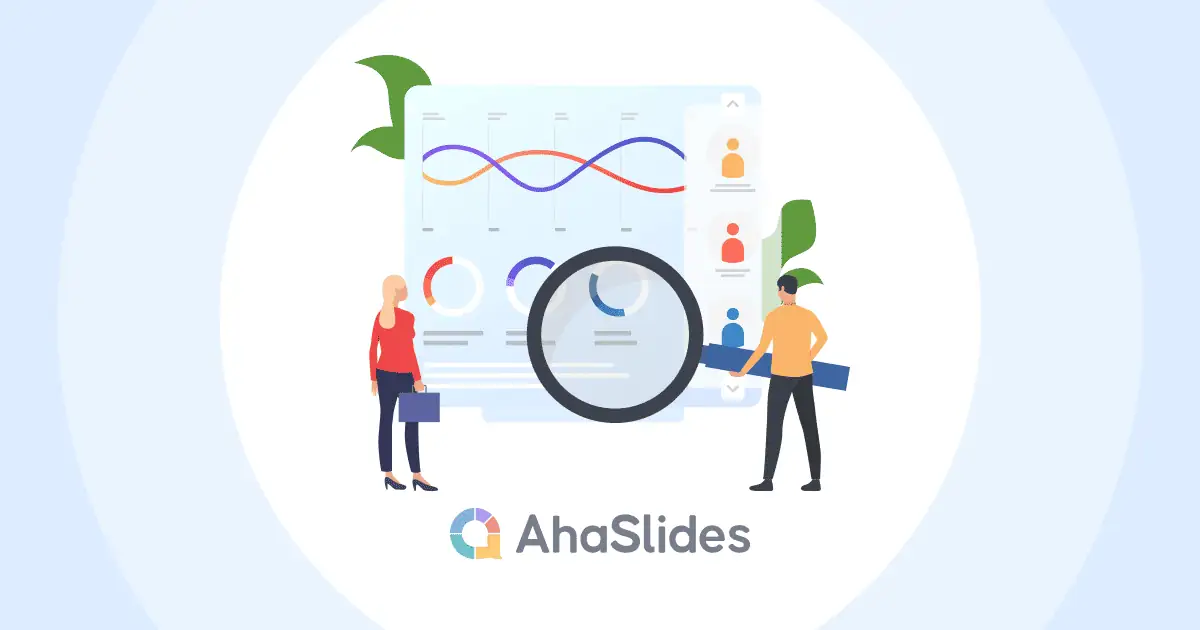Employee performance evaluation is critical to managing an organization's workforce effectively. Not only does it help managers evaluate their employees' performance, but it also enables them to provide employees with feedback and suggestions for career development.
However, with many different evaluation methods and tools available, it can be challenging to know where to begin. In this article, we'll take a closer look at employee performance evaluation’s benefits and types of employee performance evaluation and share some tips on how to get started.
Table of Contents
- What Is Employee Performance Evaluation?
- Benefits Of Employee Performance Evaluation
- How To Prepare For Employee Performance Evaluation?
- 8 Types Of Employee Performance Evaluation Methods (+Examples)
- Key Takeaways
- Frequently Asked Questions
What Is Employee Performance Evaluation?
Employee performance evaluation, also known as "employee performance review" - is the process of evaluating an employee's performance over a certain period, usually a year.
It is a way for your organization to assess the ability and performance of employees and provide information about the achievement of goals, skills, leadership ability, and employee attitudes at work.
These evaluations are typically performed by the employee's supervisor or direct manager and include 3 elements:
- Assess the goals set for employees in the previous year.
- Identify problems and challenges facing employees.
- Suggest plans or improvements for the coming year.
The outcomes of these evaluations are frequently utilized to make decisions about employee awards, incentives, or development in the future.

Why Employee Performance Evaluation Is Important?
Employee performance evaluation is important because of its benefits for both the organization and its employees. Here are some key benefits:
Benefits For Employees
- More understanding of work goals: Performance evaluation helps employees better understand their job goals, orient their work and know what needs to be done to complete the job better.
- Opportunities for growth and development: The evaluations provide employees with feedback on their strengths and areas for improvement, as well as identify opportunities for growth and development.
- Opportunities for support: After helping employees know their strengths and areas for improvement, the evaluations also help employees recommend the resources and support needed to improve work performance.
- Recognition and rewards: Employee performance evaluations can also serve as a way to recognize and reward employees for their hard work and achievements, which can motivate them to continue to perform at a high level.
- Enhanced communication: Performance evaluations are also an opportunity for employees and their managers to communicate more effectively. This can build stronger working relationships and increase trust and collaboration within the organization.

Benefits For Employers
- Employee performance evaluation: As the name implies, employee performance evaluation helps employers assess work quality and measure employee performance. This helps them identify talented employees who contribute positively to their organization.
- Employee management: These performance reviews provide employers with information on employee performance, helping them manage their people more effectively. In addition, they can make the right decisions about each employee's capacity development and career advancement.
- Motivate employees: Performance evaluations help motivate employees at work and make them feel valued and supported to develop their capacity. This helps increase employee commitment and contribution to work, improves work efficiency, and enhances the quality of the organization's products and services.
- Increase transparency: Employee performance evaluation helps to increase transparency and fairness in organizations. They also create a professional working environment and avoid dissatisfaction from employees.
How To Prepare For Employee Performance Evaluation
There are 8 necessary steps to conduct an effective employee performance evaluation, including:

1/ Define clear evaluation criteria
Before starting an evaluation, it is necessary to define the criteria that employees will be assessed against, ensuring that they are clear and relevant to their job duties.
For example, if you are evaluating the performance of your employee - an accountant, you will need to define the following evaluation criteria:
- Accurate and complete in the process of bookkeeping.
- Ability to interpret, understand, and apply new accounting skills and regulations related to the accounting profession.
- Complete accounting tasks on time and according to prescribed quality standards.
- Respond quickly and resolve accounting-related issues professionally.
These criteria are established based on the accountant's duties and the skills required for their job. These criteria are also clear and specific to give accurate evaluation results.
2/ Gather relevant information
You need to collect information and documentation related to the employee's performance, such as performance metrics, project feedback, and other relevant documents.
This information should be accurate, up-to-date, and relevant to the evaluation.
3/ Prepare performance evaluation form
An accurate and appropriate evaluation form will help you make an assessment quickly, minimizing problems arising. On the other hand, when there is a common form to evaluate employees in the same working position, it will ensure transparency, objectivity, and fairness.
The evaluation sheet will include work quality standards, work processes, expected goals, and areas for improvement of employees.
4/ Choose the types of performance evaluation
There are several ways to evaluate employee performance. Each has different advantages or works for particular evaluation goals.
- For example, if you need a multi-dimensional view of employee performance, you can choose the 360-degree evaluation method. Conversely, if you want to assess employees over time, the mid-year review may be a suitable choice.
You can refer to the next section of this article to choose the right performance evaluation method for your business or organization.
5/ Create an agenda and notify the employee
Before the evaluation meeting, create an agenda that outlines the discussed topics and the meeting's goals. This will help keep the conversation on track.
You then need to send this agenda to the employees, notify them, and ensure that the evaluation time is consistent with the employee's work schedule.
In addition, employees should be provided with instructions and explanations about the evaluation process.
6/ Ensure fairness and objectivity
It is necessary to ensure fairness and objectivity in the evaluation process, avoiding judgments based on feelings or unreasonable results.
- For example, if you are evaluating an employee's communication skills, you should use objective means recordings of conversations or emails to gauge their effectiveness. You should also ensure that the evaluation criteria used for all employees are the same and fair.
When evaluating objectively and fairly, you will have an accurate and reliable evaluation basis for making decisions regarding employee development and promotion.
7/ Feedback and recognition
Once you have assessed employees' current status and performance, it is essential to provide feedback that will help them work more effectively and efficiently. This feedback should be constructive and specific, highlighting their strengths and areas that need improvement. By receiving clear directions for improvement, employees can work towards further developing themselves and their careers.
You also can offer training programs, coaching, and necessary resources to support employees.
Additionally, recognition after the evaluation can take various forms, such as a bonus, salary increase, benefits, praise, and commendation. The recognition shows that employees are valued and appreciated by the organization.
8 Types Of Employee Performance Evaluation Methods (+Examples)
Here are the 8 types of employee performance evaluation categorized based on their nature:

Formal Reviews
#1 - Mid-year Review Examples
A mid-year review is a form of employee performance review that is conducted in the middle of the year, usually in June or July. It is an opportunity for managers and employees to evaluate progress toward achieving the year's goals, and identify issues that must be resolved to achieve the goals.
In addition, this review helps employees better understand their job performance and find direction for adjustment in the second half of the year.
By using mid-year review form, managers can better understand how to conduct an effective mid-year review, and employees can better understand how to prepare for and participate in the review process.
These examples provide a valuable guide for mid-year review questions, objectives, and responses, ensuring that managers and employees are equipped with the tools necessary for a successful review process.
#2 - Year-end Review Examples
A year-end review is an annual performance evaluation in December or early January. It gives employees an overview of their performance throughout the year, including accomplishments, areas for improvement, and opportunities for growth in the coming year.
Year end reviews include a guide to assessing employee performance, identifying areas for improvement, setting goals for the coming year, and discussing the employee's overall contribution to the organization.
By using this, managers and employees can work together to ensure effective and successful reviews.

#3 - Appraisal Comments
Providing effective appraisal comments is essential in ensuring that employees receive valuable feedback on their performance. Clear and constructive feedback can motivate your employees to continue to improve and meet organizational goals.
Without effective appraisal comments, your employees may not have a clear understanding of how well they are performing or what they need to do to improve. This can lead to confusion and dissatisfaction among employees, which can negatively impact their motivation and productivity.
Therefore, managers must provide detailed and accurate appraisal comments to ensure that employees receive valuable feedback that helps them improve and grow.
#4 - Performance Evaluation
Performance evaluation is the process of measuring and evaluating the performance of an individual, group, or organization against a set goal. It helps to identify strengths and weaknesses, provide feedback, and create plans to improve performance.
These performance evaluation examples will give managers and employees a better understanding of how to conduct effective performance evaluations, set meaningful goals, provide constructive feedback, and develop action plans for improvement.
With these examples, organizations can also ensure that their performance evaluation is fair, consistent, and transparent.

Informal Reviews
#5 - Manager Feedback Examples
Providing feedback to managers is crucial for the success of any organization. Effective feedback can help them identify areas for improvement, recognize their strengths, and understand how they are perceived by their team members.
To help employees feel comfortable providing feedback to their managers, these feedback examples include specific comments on their communication skills, decision-making abilities, leadership style, and overall performance.
By referring to these feedback examples, managers and employees will create a positive work environment.
#6 - Feedback For Colleagues Examples
Providing feedback to colleagues is essential to creating a positive and productive work environment. Feedback helps individuals understand their strengths and weaknesses, and provides them with opportunities to improve their performance. It also helps to build trust and strengthen relationships among colleagues.
Examples include constructive criticism, positive reinforcement, and specific suggestions for improvement. Applying these examples can help your business create a culture of open communication and mutual respect.
This can lead to increased collaboration, increased morale, and ultimately improved outcomes for the organization.

Multi-Rater Reviews
#7 - 360 Degree Feedback
360 degree feedback is a review process that collects feedback from multiple sources, including managers, peers, subordinates, and even external stakeholders to provide a holistic view of an individual's performance.
It is an effective way to identify areas for improvement, recognize strengths, and gain a more holistic understanding of an individual's impact on the organization.
360-degree feedback will help you conduct this type of assessment effectively and includes feedback examples on leadership qualities, problem-solving skills, communication skills, etc. This helps avoid the biases and blind spots that can occur with traditional single-person performance reviews.
Self-Review
#8 - Self Appraisal Examples
Self-appraisal is a process in which employees evaluate their own work performance, often as part of an overall performance evaluation system. It provides employees with the opportunity to reflect on their achievements, challenges, and areas for improvement.
Self-appraisal is essential because it allows employees to take ownership of their performance and development.
In addition, by referring to self appraisal examples, managers can have insight into the employee's self-awareness and ability to identify areas for improvement. It fosters open communication and trust between employees and managers, which can lead to better performance and job satisfaction.

Frequently Asked Questions
What is employee performance evaluation?
Employee performance evaluation is the process of evaluating an employee's performance over a certain period, usually a year.
What is the purpose of employee performance evaluation?
The purpose of employee performance evaluation is to provide feedback to employees on their work, to improve their performance, and to develop their skills. The outcomes of these evaluations are utilized to make decisions about future employee awards, incentives, or development.
Who conducts employee performance evaluations?
Employee performance evaluations are usually conducted by managers or supervisors who work closely with the employee being evaluated. However, in some cases, an employee may also be evaluated by a team or a group of peers.








